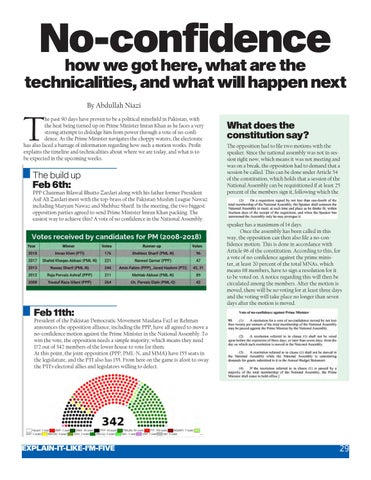No-confidence how we got here, what are the
technicalities, and what will happen next By Abdullah Niazi
T
he past 90 days have proven to be a political minefield in Pakistan, with the heat being turned up on Prime Minister Imran Khan as he faces a very strong attempt to dislodge him from power through a vote of no-confidence. As the Prime Minister navigates the choppy waters, the electorate has also faced a barrage of information regarding how such a motion works. Profit explains the timeline and technicalities about where we are today, and what is to be expected in the upcoming weeks.
The build up
Feb 6th:
PPP Chairman Bilawal Bhutto Zardari along with his father former President Asif Ali Zardari meet with the top-brass of the Pakistan Muslim League Nawaz including Maryam Nawaz and Shehbaz Sharif. In the meeting, the two biggest opposition parties agreed to send Prime Minister Imran Khan packing. The easiest way to achieve this? A vote of no confidence in the National Assembly.
Feb 11th:
What does the constitution say? The opposition had to file two motions with the speaker. Since the national assembly was not in session right now, which means it was not meeting and was on a break, the opposition had to demand that a session be called. This can be done under Article 54 of the constitution, which holds that a session of the National Assembly can be requisitioned if at least 25 percent of the members sign it, following which the
speaker has a maximum of 14 days. Once the assembly has been called in this way, the opposition can then also file a no-confidence motion. This is done in accordance with Article 96 of the constitution. According to this, for a vote of no-confidence against the prime minister, at least 20 percent of the total MNAs, which means 68 members, have to sign a resolution for it to be voted on. A notice regarding this will then be circulated among the members. After the motion is moved, there will be no voting for at least three days and the voting will take place no longer than seven days after the motion is moved.
President of the Pakistan Democratic Movement Maulana Fazl ur Rehman announces the opposition alliance, including the PPP, have all agreed to move a no-confidence motion against the Prime Minister in the National Assembly. To win the vote, the opposition needs a simple majority, which means they need 172 out of 342 members of the lower house to vote for them. At this point, the joint opposition (PPP, PML-N, and MMA) have 155 seats in the legislature, and the PTI also has 155. From here on the game is afoot to sway the PTI’s electoral allies and legislators willing to defect.
EXPLAIN-IT-LIKE-I’M-FIVE
29








